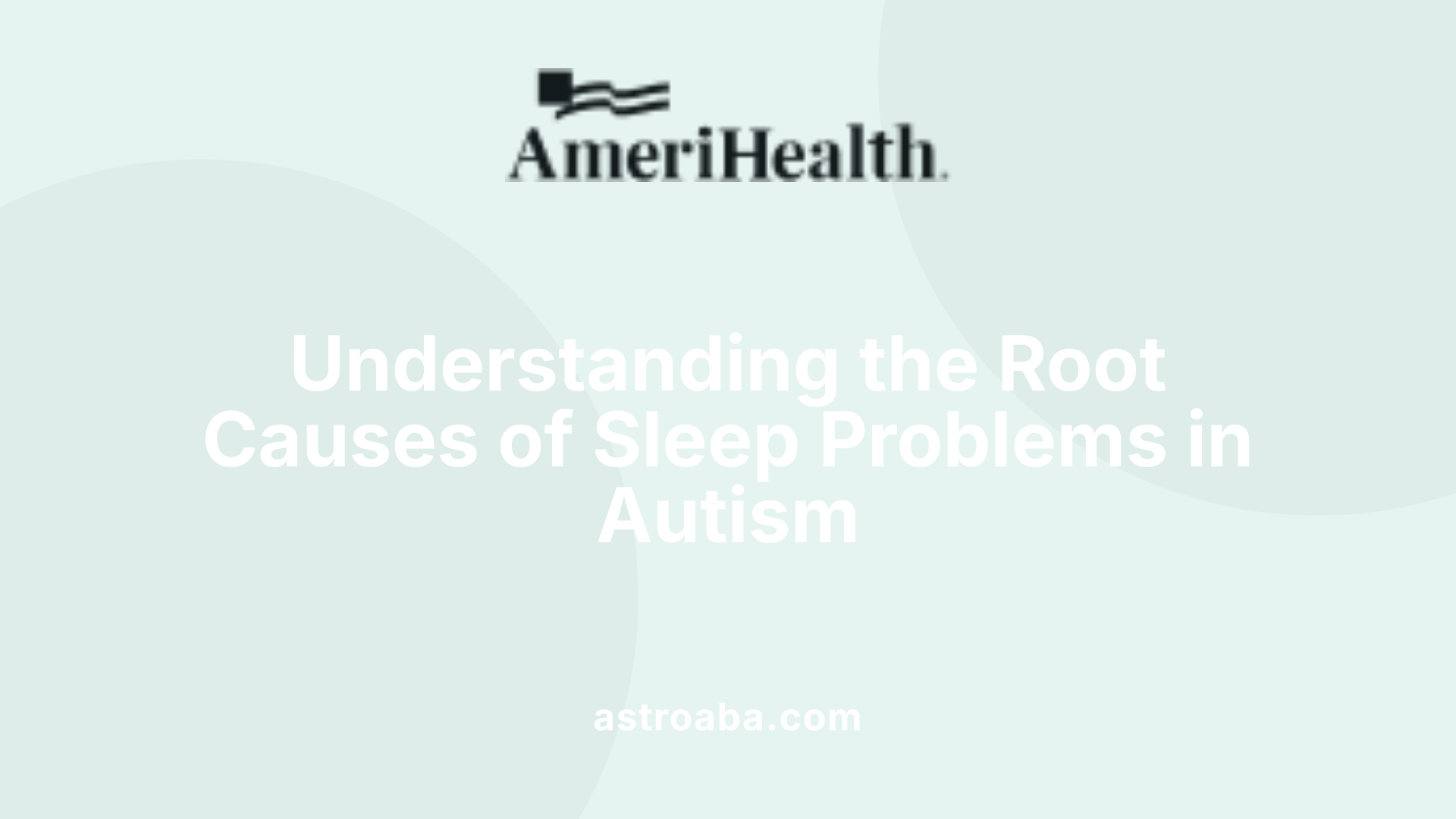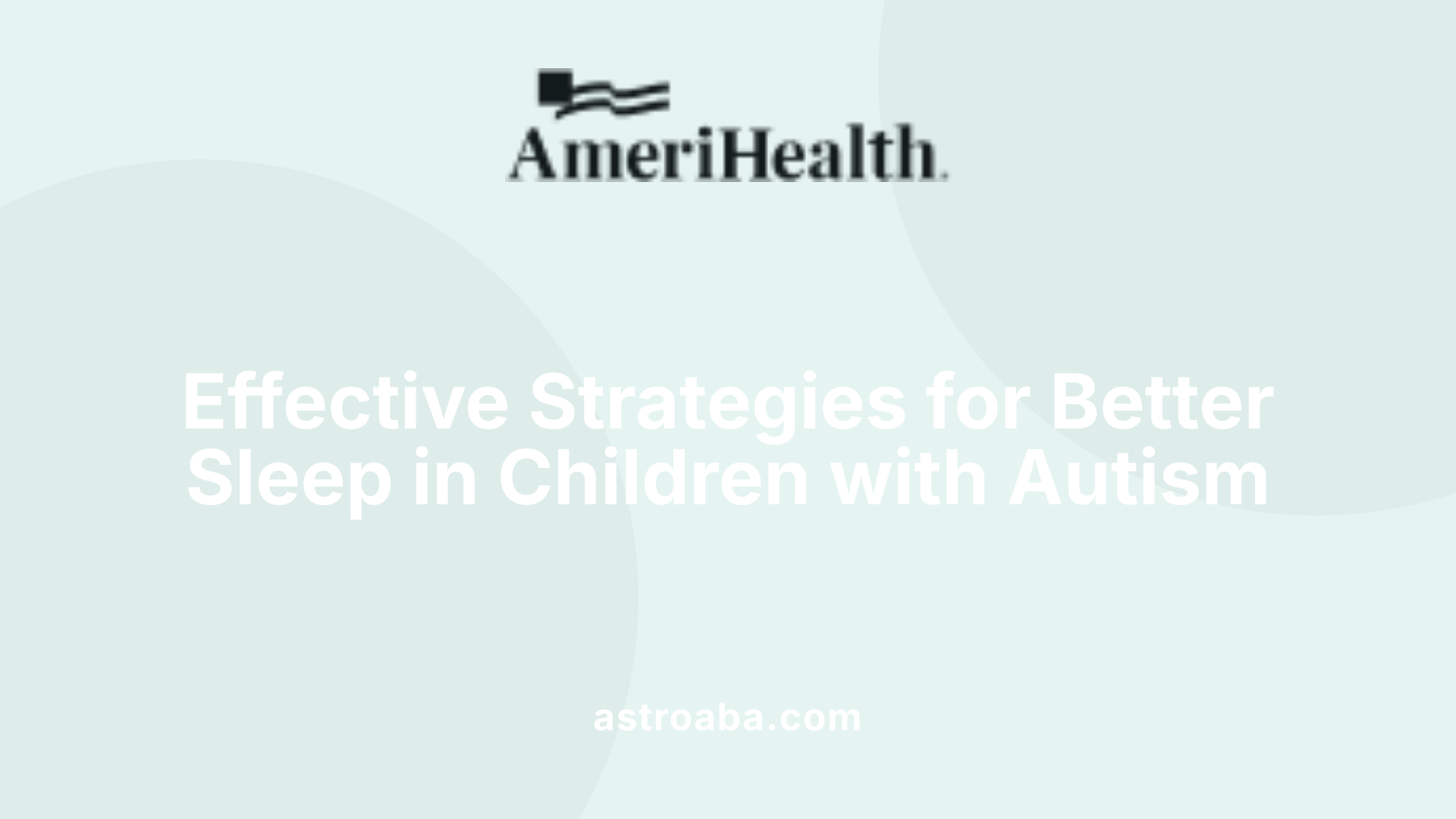How ABA Therapy Can Help with Sleep Problems
Transforming Bedtime Routines with Evidence-Based Approaches

Understanding Sleep Challenges in Children with Autism
Sleep difficulties are a common concern among children with autism, affecting between 40% and 80% of this population. These challenges can include trouble falling asleep, frequent night wakings, early morning risings, and various sleep disorders such as sleep apnea or restless legs syndrome. Such issues not only impact the child's wellbeing but can also amplify behavioral problems during the day, affecting overall quality of life. Recognizing the unique factors contributing to sleep problems—like sensory sensitivities, gastrointestinal issues, anxiety, and melatonin production differences—is crucial for effective intervention. This article explores how ABA therapy can serve as a powerful tool in addressing these sleep concerns, employing tailored strategies to promote healthy sleep habits.
Understanding the Impact of Sleep Problems in Autism
What is the prevalence of sleep problems in children with autism?
Sleep difficulties are quite common among children with autism, with studies indicating that anywhere from 40% to 80% experience some form of sleep disturbance. These issues include trouble falling asleep at the beginning of the night, waking up frequently during the night, waking too early in the morning, and other related conditions such as sleep apnea, restless legs syndrome, and circadian rhythm disorders.
Many factors contribute to these sleep issues, including sensory sensitivities, anxiety, medical conditions, and differences in melatonin production. Recognizing the high prevalence helps caregivers and professionals prioritize sleep interventions as an essential part of supporting children with autism.
What are the typical signs of sleep difficulties in children with autism?
Identifying sleep problems can sometimes be challenging because signs may overlap with other behavioral issues. Common indicators include irritability, mood swings, hyperactivity, and difficulty concentrating during the day. Greater numbers of meltdowns and increased instances of night wakings are also typical.
Other signs involve physical symptoms such as loud snoring and breathing irregularities, which could signal underlying conditions like sleep apnea. Children might also show trouble falling asleep, preference for co-sleeping, and shortened total sleep duration. Spotting these behaviors can prompt further assessment and tailored intervention strategies.
Addressing Sleep Issues with Behavioral and Environmental Strategies
Effective approaches include establishing consistent bedtime routines, which help signal the body to transition into sleep. Using visual schedules and social stories can make routines more understandable, reducing anxiety and avoiding stress around sleep time.
Environmental adjustments play a vital role—dimming lights, maintaining a cooler room temperature, minimizing noise, and reducing screen time before bed create a more comfortable sleep environment. Behavioral interventions like positive reinforcement or graduated extinction can also support healthier sleep habits.
Collateral Benefits of Improved Sleep
Research shows that addressing sleep problems can lead to improvements beyond just better rest. There are significant positive effects on daytime behavior, with reductions in stereotypic behaviors, anxiety, and mood disturbances. Additionally, enhancing sleep can improve overall quality of life for children with autism and their families.
In summary, understanding and managing sleep difficulties in children with autism is crucial. Through targeted behavioral strategies, environmental modifications, and professional support, it is possible to improve sleep patterns, which in turn positively impacts daily functioning and wellbeing.
Core Causes and Behavioral Manifestations of Sleep Difficulties

What factors contribute to sleep problems in children with autism?
Children with autism often face unique challenges that make it harder for them to get restful sleep. Contributing factors include sensory sensitivities, such as loud noises or bright lights, which can make relaxing difficult.
Anxiety and difficulties with self-regulation are common, leading to heightened stress around bedtime. Differences in melatonin production—which helps regulate sleep-wake cycles—can also disrupt sleep patterns. Additionally, gastrointestinal issues, certain medical conditions, and side effects from medications may interfere with a child's ability to fall asleep or stay asleep.
Other factors like medical health concerns and environmental influences can further complicate sleep routines in children with autism.
What are common sleep issues experienced by children with autism?
Many children on the autism spectrum encounter various sleep-related problems. These include:
| Sleep Issue | Description | Examples |
|---|---|---|
| Sleep-onset insomnia | Difficulty falling asleep at the beginning of the night. | Taking over an hour to fall asleep. |
| Sleep-maintenance insomnia | Waking up frequently during the night or having trouble staying asleep. | Multiple night wakings requiring parental intervention. |
| Early waking | Waking up much earlier than desired, often before dawn. | Rising at 4:00 or 5:00 a.m. |
| Sleep apnea | Breathing interruptions during sleep caused by airway blockage. | Loud snoring, gasping during sleep. |
| Restless legs syndrome | An uncontrollable urge to move the legs due to discomfort. | Picking or jiggling legs before sleep. |
| Circadian rhythm disorders | Misalignment of the internal clock causing irregular sleep schedules. | Sleeping during the day and waking at night. |
| Night terrors and sleepwalking | Parasomnias involving intense fear during sleep or physical activity during partial arousals. | Sitting up terrified during a night terror. |
Understanding these underlying causes and behaviors helps in tailoring effective strategies, such as maintaining consistent routines and adjusting the sleep environment, to improve sleep quality in children with autism.
How ABA Therapy Approaches Sleep Challenges

What methods and strategies are used in ABA therapy to address sleep issues?
ABA therapy employs a range of tailored techniques to improve sleep in children with autism. Initially, therapists conduct comprehensive assessments to identify underlying factors like anxiety, sensory sensitivities, or medical issues contributing to sleep disruptions. Based on these assessments, individualized treatment plans are developed.
A core strategy involves establishing consistent bedtime routines. These routines typically include calming activities such as sensory modifications—using weighted blankets or white noise—to create a soothing environment. Visual supports and social stories are used to prepare children for bedtime, helping reduce anxiety and increase understanding of sleep expectations.
Positive reinforcement plays a vital role. Children are rewarded for practicing independent sleep skills, following routines, and using self-soothing methods. Techniques like gradual fading of caregiver presence, scheduled awakenings, and environmental adjustments (e.g., dim lighting, cooler room temperature) help children learn to self-regulate and fall asleep more easily.
Behavioral techniques such as functional communication training (FCT) are also used so children can express their needs, minimizing distress that might delay sleep. Each intervention is personalized, ensuring it suits the child's unique sensory and behavioral profile.
How does ABA therapy relate to sleep hygiene and better sleep?
ABA therapy promotes good sleep hygiene by teaching routines that signal the body to prepare for sleep. Through visual schedules, consistent bedtimes, and soothing pre-sleep activities, behaviors are shaped to foster a healthy sleep pattern.
Interventions like the bedtime fading technique gradually shift the child's sleep schedule to a more desirable time, helping establish a natural sleep cycle. Graduated extinction involves briefly ignoring minor night wakings to encourage self-soothing without reliance on caregivers.
Behavior analysts also utilize sleep diaries and environmental modifications—such as reducing screen time and adjusting lighting—to minimize sleep-disrupting stimuli. These practices reduce sleep disturbances, which can have positive collateral effects on daytime behaviors, including reductions in irritability and hyperactivity.
Overall, ABA therapy's focus on teaching and reinforcing structured routines, relaxation techniques, and environmental adjustments supports better sleep hygiene, leading to improved overall functioning for children with autism.
Efficacy and Evidence Supporting ABA for Sleep Improvement
 Research indicates that ABA therapy can be highly effective in addressing sleep difficulties faced by children with autism. Numerous studies have shown that behavioral interventions grounded in ABA techniques significantly reduce issues such as sleep-onset delay, night wakings, and irregular sleep patterns. These approaches typically include establishing consistent bedtime routines, creating a calming sleep environment, and reinforcing sleep-appropriate behaviors through positive reinforcement and gradual extinction strategies.
Research indicates that ABA therapy can be highly effective in addressing sleep difficulties faced by children with autism. Numerous studies have shown that behavioral interventions grounded in ABA techniques significantly reduce issues such as sleep-onset delay, night wakings, and irregular sleep patterns. These approaches typically include establishing consistent bedtime routines, creating a calming sleep environment, and reinforcing sleep-appropriate behaviors through positive reinforcement and gradual extinction strategies.
For example, behavioral sleep interventions often incorporate visual schedules and social stories, helping children understand and follow bedtime routines, which reduces anxiety and resistance. Techniques like sleep fading and fading bedtime routines are customized to each child's needs, often leading to quicker sleep onset and longer sleep duration.
Collateral benefits of these interventions extend beyond nighttime sleep. Many studies report improvements in daytime behaviors such as reduced irritability, hyperactivity, and anxiety. There are also notable enhancements in overall quality of life for both children and their families.
Parent involvement is crucial. Training caregivers to implement sleep strategies ensures consistency and reinforces learned behaviors outside clinical settings. Families are equipped with tools like sleep checklists and visual supports, which empower them to maintain progress.
Evidence Supporting the Use of ABA for Sleep in Children with Autism
| Study Type | Findings | Additional Details |
|---|---|---|
| Randomized Control Trials | Demonstrated decreases in night wakings and sleep onset time | Double-blind protocols support causality |
| Case Studies | Personalized ABA strategies successfully improved sleep | Long-term follow-up showed sustained progress |
| Meta-analyses | Consistent evidence of sleep improvements | Collateral benefits in daytime behavior |
Success Stories of ABA and Sleep Improvements
Real-world examples reinforce the effectiveness of ABA interventions. Children who previously experienced frequent night wakings or difficulty falling asleep showed marked improvement after tailored programs. Techniques like incorporating social stories about bedtime, using sleep signals, and implementing bedtime fading helped children transition more smoothly into sleep cycles.
Families reported fewer nighttime disruptions, increased sleep duration, and better daytime functioning. Follow-up assessments often confirmed that these improvements endured, highlighting the value of individualized ABA strategies.
In summary, clinical evidence supports ABA's role in improving sleep among children with autism, leading to benefits that extend into daily life and overall wellbeing.
Practical Guidance for Parents and Caregivers

Developing consistent routines
Establishing a predictable bedtime routine is crucial for children with autism. A routine that moves from active to passive activities signals the body to prepare for sleep. Incorporate calming activities such as reading a social story, listening to soft music, or engaging in gentle sensory activities. Using visual schedules can help children understand what to expect, reducing anxiety and resistance.
Monitoring sleep patterns and collaborating with professionals
Keeping a sleep diary allows caregivers to track patterns, identify issues, and tailor strategies accordingly. Note the time it takes for your child to fall asleep, night wakings, and daytime behaviors. Sharing this information with behavioral therapists or sleep specialists can help create a personalized plan. Regular collaboration with healthcare providers ensures that any medical or sensory issues are addressed.
Implementing ABA techniques like positive reinforcement and fading
ABA therapy can teach children healthy sleep behaviors. Techniques such as positive reinforcement reward desired behaviors like staying in bed or falling asleep independently. Gradual fading of parental interventions, like slowly increasing the time between visits during extinction procedures, can help establish routine independence. Consistent use of these techniques fosters a sense of security and promotes better sleep.
Guidance for managing sleep problems
Parents should develop tailored, consistent bedtime routines with calming activities, reinforced through rewards or praise. Techniques like sleep fading, scheduled awakenings, and graduated extinction can be effective in reducing sleep-onset delays and night wakings. Monitoring progress through sleep diaries allows for adjustments to the plan. Working closely with a team of therapists and healthcare providers ensures a comprehensive approach suited to each child's unique needs.
Implementing these strategies consistently helps create a stable environment, reducing anxiety and improving sleep quality for children with autism, ultimately benefiting their daytime behavior and overall well-being.
Success Stories and Practical Applications of ABA Sleep Interventions
Are there success stories or case examples of ABA therapy improving sleep in children with autism?
Yes, numerous case studies highlight the effectiveness of ABA therapy in addressing sleep difficulties among children with autism. These stories showcase how tailored interventions can promote better sleep habits, which in turn enhances overall well-being for both children and their families.
One common approach involves using social stories tailored to the child's specific needs. These stories explain bedtime routines in a clear, reassuring way, helping children understand what to expect and reducing bedtime anxiety. For example, a child who previously struggled with night wakings showed significant improvement after a social story was introduced, which fostered a sense of predictability around bedtime.
Behavioral checklists and visual schedules are also employed to guide children through pre-sleep routines. These visual aids create a familiar, step-by-step process that the child can follow actively, reducing resistance and sleep onset delays. In many cases, implementing such strategies has decreased the frequency of night wakings and improved sleep duration.
Studies also report that involving children in managing their sleep routines fosters a sense of control and cooperation. For instance, some children are taught to recognize when they are sleepy and to signal for assistance rather than engaging in disruptive behaviors. This active participation makes the routines more engaging and effective.
Furthermore, the customization of strategies based on thorough assessments ensures interventions address individual sensory sensitivities, medical issues, and behavioral patterns. For example, a child with sensory sensitivities might benefit from weighted blankets or sensory-friendly bedding, while another with anxiety might respond well to relaxation techniques incorporated into their bedtime routine.
Overall, these tailored interventions and active participation lead to sustainable sleep improvements. Families often report better mood, increased daytime functioning, and reduced behavioral problems. These success stories underscore how ABA techniques, with appropriate customization, can make a profound difference in the sleep health of children with autism.
| Case Type | Intervention Strategy | Result | Additional Notes |
|---|---|---|---|
| Night Wakings | Social Stories + Visual Schedules | Reduced wakefulness at night | Customized stories for child's interests |
| Sleep Onset | Gradual extinction + Reinforcement | Faster sleep onset | Reinforcement for independent sleep cues |
| Sensory Sensitivities | Weighted Blanket + Calm Environment | Less sensory overload | Tailored to child's sensory profile |
| Anxiety-Related Sleep Issues | Mindfulness + Visual Supports | Decreased bedtime anxiety | Friendly, child-centered approach |
These examples demonstrate that success in improving sleep among children with autism through ABA is feasible, practical, and highly individualized.
Conclusion and Future Perspectives
 The importance of sleep for overall ASD management cannot be overstated. Sleep difficulties are prevalent among children with autism, affecting up to 80% of this population. Poor sleep not only exacerbates core ASD symptoms but also impairs learning, emotional regulation, and family dynamics. Addressing these issues is essential because quality sleep can lead to significant improvements in daytime behavior, social skills, and overall well-being.
The importance of sleep for overall ASD management cannot be overstated. Sleep difficulties are prevalent among children with autism, affecting up to 80% of this population. Poor sleep not only exacerbates core ASD symptoms but also impairs learning, emotional regulation, and family dynamics. Addressing these issues is essential because quality sleep can lead to significant improvements in daytime behavior, social skills, and overall well-being.
Applied Behavior Analysis (ABA) plays a vital role within comprehensive treatment plans for children with autism. Its structured approach allows therapists to tailor interventions that target specific sleep-related behaviors. By focusing on reinforcement, environmental adjustments, and teaching healthy routines, ABA helps transform sleep problems into teachable skills. This integration ensures that improving sleep is part of a holistic strategy aimed at enhancing each child's overall development and quality of life.
Emerging research and ongoing developments in the field continue to expand the possibilities for effective sleep management. Studies indicate that behavioral sleep interventions based on ABA techniques can lead to collateral benefits such as reduced stereotypic behaviors and improved mood. New methods involving visual supports, relaxation techniques, and possibly melatonin under medical supervision are being explored to further optimize outcomes.
Future directions in ABA and sleep management are focused on refining existing techniques and developing innovative approaches. Advances may include integrating technology for personalized monitoring, enhancing caregiver training, and developing protocols that address sensory sensitivities more effectively. Continued research aims to create more effective, accessible, and sustainable solutions that can be adapted to individual needs improving outcomes for children with autism.
As the understanding of sleep's role in autism deepens, so does the potential for ABA-based interventions to foster better sleep habits. The goal is not only to reduce sleep problems but also to improve overall functioning, leading to a more balanced and healthier life for children with ASD and their families.
Achieving Restorative Sleep for Better Outcomes
Effective management of sleep problems in children with autism requires tailored, evidence-based approaches. ABA therapy stands out as a comprehensive method that not only addresses sleep issues directly but also enhances overall developmental progress. As research continues to evolve, integrating innovative strategies within ABA frameworks promises even greater success in helping children achieve the restful sleep they need for optimal growth and wellbeing.
References
- ABA Therapy And Sleep Patterns: The Key To Sweeter Dreams
- Can't sleep? ABA therapy can help! - The Behavior Exchange
- Sleep Difficulties in Children with Autism - Childwise ABA
- Systematic review of the collateral effects of behavioral sleep ...
- Sleep and Autism: Current Research, Clinical Assessment, and ...
- Systematic review of the collateral effects of behavioral sleep ...
- Efficacy of parent training incorporated in behavioral sleep ...
- Treating Sleep Disorders - Autism Research Institute
Recent articles

The Role of Prompting and Fading in ABA Therapy Programs
Enhancing Autism Interventions Through Systematic Support Reduction

The Role of ABA Therapy in Supporting Community Participation
Enhancing Lives Through Community-Focused ABA Interventions

The Role of ABA Therapy in Encouraging Initiative and Motivation
Unlocking Potential: How ABA Empowers Children to Take Initiative

How ABA Therapy Helps Children Develop Initiation and Motivation
Unlocking Potential: The Power of ABA in Fostering Child Independence

How ABA Therapy Encourages Participation in Cooperative Group Activities
Fostering Social Skills Through ABA Interventions

How ABA Therapy Supports Independent Task Initiation in Children
Empowering Children to Begin with Confidence

How ABA Therapy Helps Children Build Resilience in Challenging Situations
Building Emotional Strength Through ABA Therapy

The Impact of ABA Therapy on Reducing Anxiety in Social Settings
Transforming Social Experiences: How ABA Therapy Eases Autism-Related Anxiety

Strategies for Teaching Self-Monitoring Through ABA
Empowering Independence: Techniques to Foster Self-Monitoring with ABA

The Benefits of Combining ABA with Speech and Language Therapy
Integrating Treatment Approaches to Maximize Developmental Progress

Strategies for Teaching Cooperative Problem-Solving Through ABA
Enhancing Collaborative Skills with ABA: Proven Strategies and Techniques

How ABA Therapy Encourages Independent Participation in Daily Tasks
Empowering Autonomy: How ABA Therapy Builds Independence in Daily Life

Creating an Effective Learning Environment at Home for ABA Therapy
Building a Supportive Home Environment for ABA Success

How ABA Therapy Encourages Following Safety Rules at Home and School
Empowering Children with Autism to Follow Essential Safety Rules

How ABA Therapy Encourages Communication Using Gestures and Signs
Enhancing Social Skills with Targeted Gesture Teaching

Common ABA Therapy Techniques for Reducing Aggression
Innovative Strategies in ABA to Minimize Aggressive Behaviors

How ABA Therapy Encourages Communication Using Gestures and Signs
Unlocking the Power of Gestures and Signs in Autism Therapy

How ABA Therapy Encourages Appropriate Social Greetings
Enhancing Social Skills Through Evidence-Based Interventions

Addressing Social Anxiety Using ABA-Based Techniques
Harnessing ABA to Alleviate Social Anxiety

Famous Politicians With Autism
Celebrating Neurodiversity: Insights into Autism and Notable Figures

How ABA Therapy Can Help with Anxiety in Children with Autism
Unlocking Emotional Well-Being: The Power of ABA in Managing Autism-Related Anxiety

The Impact of ABA Therapy on School Success
Enhancing Educational Outcomes with Systematic Interventions

The Importance of Social Stories in ABA Therapy
Harnessing Social Stories to Enhance Social Skills in Autism Interventions

Mild Autism
Understanding the Nuances of Mild Autism

What Are Functional Behavior Assessments (FBA) in ABA Therapy?
Unlocking the Secrets Behind Behavior: The Power of FBAs in ABA

Early Signs Of Autism In Babies And Kids
Recognizing Early Indicators to Support Developmental Health

How to Find Funding for ABA Therapy Services
Unlocking Funding Opportunities for Autism Treatments

How to Help a Child with Autism Transition to ABA Therapy
Supporting Children Through Transition Phases in ABA Therapy

Do Autistic People Get Injured More?
Examining Injury Risks in Individuals with Autism Spectrum Disorder

How ABA Therapy Can Help with Executive Functioning Challenges
Unlocking Skills: The Impact of ABA on Executive Functioning in Autism

What is the Premack Principle in ABA Therapy?
Unlocking Motivation: The Power of the Premack Principle in ABA Therapy

Low-Functioning Autism
Understanding the Challenges and Supports for Low-Functioning Autism

Low-Functioning Autism
Understanding the Challenges and Supports for Low-Functioning Autism

How ABA Therapy Can Help with Playdates and Social Events
Unlocking Social Success: How ABA Therapy Facilitates Playdates and Community Engagement

How ABA Therapy Can Address Impulse Control Issues
Mastering Behavioral Growth: The Power of ABA in Impulse Control

Book, Movie, and TV Characters on the Autism Spectrum
Enhancing Understanding Through Fictional Portrayals

Book, Movie, and TV Characters on the Autism Spectrum
Enhancing Understanding Through Fictional Portrayals

The Role of Visual Supports in ABA Therapy
Enhancing Autism Interventions with Visual Supports

What Is Pervasive Developmental Disorder
Understanding the Spectrum of Developmental Challenges

How ABA Therapy Helps with Emotional Regulation
Empowering Emotional Resilience in Children with Autism

What is Task Analysis in ABA Therapy?
Unveiling the Foundations of Task Analysis in ABA Therapy

How ABA Therapy Can Improve Play Skills
Unlocking Growth: The Power of ABA in Enhancing Play Skills

Air Pollution and Autism
Unveiling the Environmental Impact on Developing Minds

How ABA Therapy Can Help with Bullying Prevention
Building Respect and Resilience Through ABA

How ABA Therapy Can Be Used to Teach Problem-Solving Strategies
Empowering Individuals with Autism Through Targeted Problem-Solving Skills

Can Autistic People Work?
Unlocking Potential: The Realities of Employment for Autistic Individuals

How ABA Therapy Can Help with Homework and Academics
Empowering Academic Success with ABA Therapy

Common Myths About ABA Therapy Debunked
Unmasking Autism Treatment: The Truth About ABA Therapy

Does Aluminum Cause Autism?
Unraveling the Link: Aluminum and Autism Spectrum Disorder

How ABA Therapy Can Support Emotional Expression and Understanding
Unlocking Emotional Growth in Autism Through ABA Therapy

The Role of ABA Therapy in Helping Children Learn Road Safety
Empowering Safe Journeys: How ABA Therapy Fosters Road Safety Skills in Children

The Role of Group ABA Therapy in Social Development
Enhancing Social Skills Through Collective Strategies

What Is Autistic Burnout?
Understanding the Hidden Struggle of Autistic Burnout

How Do You Get An Autistic Child To Keep Their Shoes On?
Mastering Comfort and Compliance with Shoes for Autistic Children

The Role of ABA Therapy in Addressing Food Aversions and Picky Eating
Transforming Mealtimes: How ABA Therapy Supports Children with Autism

How ABA Therapy Can Assist in Reducing Perfectionism and Anxiety
Harnessing Behavioral Science to Ease Perfectionism and Anxiety

What Is Defeat Autism Now?
Unveiling the Roots and Realities of the DAN Movement

How ABA Therapy Can Help Children Develop Conflict Resolution Skills
Building Bridges: Empowering Children with Conflict Resolution Skills through ABA

OCD vs. Autism
Unraveling the Complex Relationship Between OCD and Autism

Temper Tantrums A Sign Of Autism
Understanding the Complex Relationship Between Temper Tantrums and Autism Spectrum Disorder

How to Pass the BCBA Exam
Your Ultimate Guide to Success in the BCBA Exam

Autism and Addiction's Close Connection
Unraveling the Complex Interplay Between Autism and Substance Use

Autism Facial Expressions
Decoding Emotions: The Complex World of Facial Expressions in Autism

How ABA Therapy Can Help Reduce Anxiety Around Doctor and Dentist Visits
Transforming Medical Experiences for Children with Autism

How ABA Therapy Can Help with Navigating Social Media Responsibly
Empowering Safe Online Engagement for Children with Autism through ABA

How to Choose an Autism Charity
Navigating the Spectrum of Support: A Guide to Selecting the Right Autism Charity

What is Precision Teaching in ABA Therapy?
Harnessing Data-Driven Strategies for Skill Mastery

Autism and Obesity
Understanding the Overlap: Autism and the Rising Concern of Obesity

Individualized Education Programs (IEPs) for Autism
Supporting Success: A Comprehensive Guide to IEPs for Children with Autism

How to Integrate ABA Therapy into Everyday Routines
Transforming Daily Life with ABA Strategies

What is Shaping in ABA Therapy?
Understanding the Core of Behavior Shaping in Autism Interventions

Autism vs. ADHD
Understanding the Distinction and Overlap of Neurodevelopmental Disorders

Is RBT Certification Worth It?
Unveiling the Value of RBT Certification in the Field of ABA

How Negative Reinforcement Works in ABA Therapy
Unlocking the Power of Negative Reinforcement in Behavioral Therapy

How to Advocate for ABA Therapy Services in Schools
Navigating Advocacy for School-Based ABA Therapy

How ABA Therapy Can Address Impulsivity in Children
Transforming Child Behavior: The Power of ABA Therapy Against Impulsivity

Understanding the Different Types of ABA Therapy Programs
Exploring the Spectrum of ABA Therapy Approaches

How ABA Therapy Can Address Regression in Autism
Understanding Regressive Autism and the Role of ABA Therapy

High Functioning Autism And Anger
Understanding Emotional Challenges in High-Functioning Autism

Autism and Puberty
Understanding Puberty in Autistic Youth: Challenges and Support Strategies

Challenging Autism Behavior Problems
Navigating the Complex Landscape of Autism-Related Behavioral Challenges

How ABA Therapy Can Help with Sleep Problems
Transforming Bedtime Routines with Evidence-Based Approaches

How ABA Therapy Can Help Improve Cooperation and Compliance
Fostering Respectful Engagement: The Role of ABA in Enhancing Cooperation and Compliance

Eating Disorders And Autism
Unraveling the Complex Relationship Between Autism and Eating Disorders

How Schedules of Reinforcement Work in ABA Therapy
Mastering Reinforcement Patterns to Foster Behavior Change

How to Incorporate ABA Therapy into a Homeschooling Program
Transforming Homeschooling with Evidence-Based Strategies

What Are the Most Common Misconceptions About ABA Therapy?
Unveiling the Truth Behind ABA Therapy: Myths vs. Facts

What is Demand Fading in ABA Therapy?
Demystifying Demand Fading in ABA Therapy

What Are ABA Assessments and How Do They Work?
Understanding the Foundations of ABA Assessments

What is an AAC Device for Autism?
Unlocking Communication: The Power of AAC Devices for Autism

How ABA Therapy Can Help Children Understand and Express Emotions
Enhancing Emotional Understanding Through Evidence-Based Interventions

How To Prevent Autism
Emerging Strategies to Reduce Autism Risk in Children

How ABA Therapy Can Improve Verbal and Nonverbal Communication
Unlocking Communication: The Power of ABA Therapy for Children with Autism

Natural Environment Teaching (NET): How It Helps with Skill Generalization
Unlocking Practical Learning in Natural Settings

What Is Play Therapy For Autism?
Unlocking the Potential of Play in Autism Therapy

How ABA Therapy Can Improve Fine and Gross Motor Skills
Enhancing Movement and Independence Through ABA Strategies

Calming Strategies For Kids With Autism
Understanding and Supporting Calmness in Children with Autism

Autism Evaluation
Comprehensive Insights into Autism Assessment and Diagnosis

How to Support Your Child's ABA Therapy at Home
Empowering Your Child’s Development at Home with ABA Support

Autism Prevalence Increases in Arizona
Rising Autism Rates Signal Changing Landscape in Arizona

